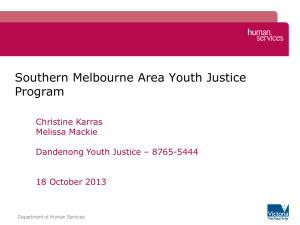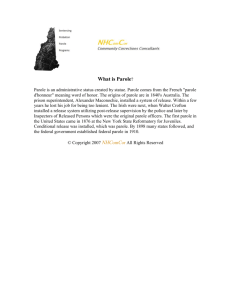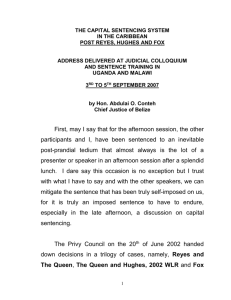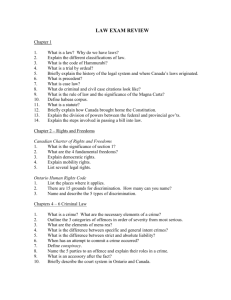Ronald van der Plaat v. New Zealand
advertisement
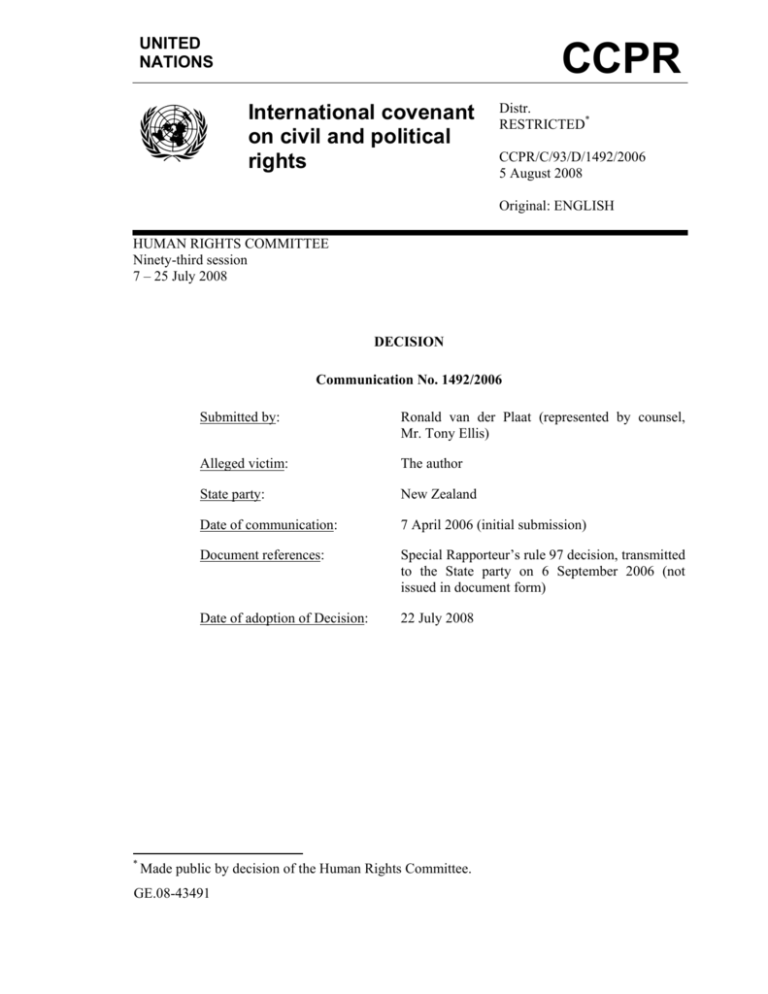
UNITED NATIONS CCPR International covenant on civil and political rights Distr. RESTRICTED* CCPR/C/93/D/1492/2006 5 August 2008 Original: ENGLISH HUMAN RIGHTS COMMITTEE Ninety-third session 7 – 25 July 2008 DECISION Communication No. 1492/2006 * Submitted by: Ronald van der Plaat (represented by counsel, Mr. Tony Ellis) Alleged victim: The author State party: New Zealand Date of communication: 7 April 2006 (initial submission) Document references: Special Rapporteur’s rule 97 decision, transmitted to the State party on 6 September 2006 (not issued in document form) Date of adoption of Decision: 22 July 2008 Made public by decision of the Human Rights Committee. GE.08-43491 CCPR/C/93/D/1492/2006 Page 2 Subject matter: Adjustment of sentencing and parole schemes after conviction and sentence Procedural issues: Sufficient status of victim - sufficient substantiation, for purposes of admissibility Substantive issues: Retrospective imposition of heavier sentence – discrimination – arbitrary detention Articles of the Optional Protocol: article 9, paragraphs 1 and 4; article 15 and article 26 Articles of the Covenant: article 2 [Annex] CCPR/C/93/D/1492/2006 Page 3 ANNEX DECISION OF THE HUMAN RIGHTS COMMITTEE UNDER THE OPTIONAL PROTOCOL TO THE INTERNATIONAL COVENANT ON CIVIL AND POLITICAL RIGHTS Ninety-third session concerning Communication No. 1492/2006* Submitted by: Ronald van der Plaat (represented by counsel, Mr. Tony Ellis) Alleged victim: The author State party: New Zealand Date of communication: 7 April 2006 (initial submission) The Human Rights Committee, established under article 28 of the International Covenant on Civil and Political Rights, Meeting on 22 July 2008, Adopts the following: DECISION ON ADMISSIBILITY 1. The author of the communication, initially dated 7 April 2006, is Ronald van der Plaat. He claims to be a victim of violations by New Zealand of article 9, paragraphs 1 and 4; article 15 and article 26 of the Covenant. He is represented by counsel, Mr. Tony Ellis. The facts as presented 2.1 On 18 October 2000, the author was found guilty by a jury of two representative charges of rape, one representative count of indecent assault and three representative counts of unlawful sexual connection committed against his daughter, spanning a ten year period. He was sentenced to a total of fourteen years imprisonment. In the light of evidence described in the Court of Appeal as “overwhelming”, he withdrew an appeal against sentence on the advice of his then counsel on the ground that it had no chance of success, and instead appealed against his sentence * The following members of the Committee participated in the examination of the present communication: Mr. Abdelfattah Amor, Mr. Prafullachandra Natwarlal Bhagwati, Ms. Christine Chanet, Mr. Maurice Glèlè Ahanhanzo, Mr. Yuji Iwasawa, Mr. Edwin Johnson, Mr. Ahmed Tawfik Khalil, Mr. Rajsoomer Lallah, Ms. Zonke Zanele Majodina, Ms. Iulia Antoanella Motoc, Mr. Michael O’Flaherty, Ms. Elisabeth Palm, Mr. José Luis Pérez Sanchez-Cerro, Mr. Rafael Rivas Posada, Sir Nigel Rodley, Mr. Ivan Shearer and Ms. Ruth Wedgwood CCPR/C/93/D/1492/2006 Page 4 only on the ground that it was manifestly excessive considering his advanced age, at the time of sentence, of 66 years. The Court of Appeal dismissed the appeal on 1 August 2001 stating that the author’s age had been expressly taken into account as a mitigating factor. His appeal to the same court against the conviction was withdrawn on the advice of his then counsel that it had no chance of success. 2.2 At the time of the author’s conviction and sentence, the applicable terms of the Criminal Justice Act 1985 entitled the author to release on conditions after serving two-thirds of his sentence, that is, on 18 February 2009 after having served nine years and four months of the 14 year sentence. 2.3 After both the commission of the offences (August 1983-October 1992) and the author’s conviction and sentence (2000-2001), the relevant provisions of the Criminal Justice Act 1985 governing both sentencing and release were repealed and replaced with the Sentencing Act 2002 and the Parole Act 2002, which entered into force on 30 June 2002. 2.4 Under the old provisions, prior to 30 June 2002, which remained applicable to the author, an offender was entitled to be released after serving two-thirds of a determinate sentence (unless release was postponed due to prison disciplinary offences, or an order was sought that a full term of imprisonment be served). Under the new provisions, after 30 June 2002, there would be eligibility for parole, where a minimum term of imprisonment had been imposed, after two-thirds of that term had been served; if no minimum term was imposed, eligibility for parole would accrue after one-third of the sentence had been served. 2.5 Were that latter rule applied to the author, he contends that he would have been eligible for parole four years and eight months earlier than under the previous legislation, that is, on 18 June 2007. The Sentencing Act and the New Zealand Bill of Rights Act both contain the right to a lesser penalty if the penalty for an offence is reduced between the time of commission of the offence and sentencing. The complaint 3.1 The author claims that the facts disclose violations of article 9, paragraphs 1 and 4; article 15 and article 26 of the Covenant. The principal claim is that the sentencing regime applied to him breaches articles 15 and 26, and that in consequence his detention is arbitrary in breach of article 9, paragraphs 1 and 4. 3.2 With regard to the claim under article 15, the author argues that the lighter penalty provided by the 2002 Act subsequent to the commission of the offence should have been applied to him. He considers that minimum non-parole periods are “sentences” and that this is confirmed by the wording contained in the Sentencing Act 2002. He acknowledges that there is relevant jurisprudence by the Committee, but invites it to adopt a “purposive approach” to the application of article 15(1) andto apply in particular a broad interpretation of the term “penalty”. 3.3 The author notes that the Committee’s jurisprudence provides little guidance on the matter, as the two cases which squarely raised the current point were resolved on other grounds. In Van CCPR/C/93/D/1492/2006 Page 5 Duzen v Canada,1 the author was released on mandatory supervision rather than serving a full term, while in MacIsaac v Canada2 the author had failed to prove that retroactive application of more liberal parole laws would have resulted in his being released earlier. Nor does academic commentary offer guidance.3 3.4 With regard to article 26, the author claims that there is discrimination between those offenders who were sentenced before 30 June 2002 (date of the entry into force of the Parole Act 2002) and those offenders sentenced after that date. 3.5 By way of consequential violations, the author claims that, if breaches of article 15 and 26 are found, his detention is necessarily arbitrary and in breach of article 9; paragraphs 1 and 4. 3.6 As to the exhaustion of domestic remedies, the author claims that at the time of the original dismissal of his appeal the only available option would have been an appeal against sentence to the Privy Council, a form of appeal which in 150 years had not been successful in such cases and would not have been legally aided, and therefore futile. 3.7 With respect to the actual claim before the Committee, the author has not pursued any claim before the courts. He refers to a May 2005 decision of the Supreme Court of New Zealand, 4 interpreting section 6 of the Sentencing Act 2006 which provides that anyone convicted of “an offence in respect of which the penalty has been varied between the commission of the offence and sentencing” has “the right … to the benefit of the lesser penalty”. The Court concluded, by a majority, that a statutory change from a regime of mandatory release on conditions (and subject to recall) after two-thirds of sentence, to a regime of release after full sentence was not a change in “penalty”; the penalty as prescribed by law for the underlying conduct had remained unchanged. In light of this jurisprudence, the author argues it would be futile to pursue an appeal to the Supreme Court to argue for the meaning that he contends in this communication. State party’s submissions on the admissibility and merits 4.1 By Notes verbales of 3 November 2006 and 6 March 2007, the State party contested both the admissibility and merits of the communication. 4.2 The State party disputes that the author is a victim in terms of article 2 of the Optional Protocol, as it is in fact hypothetical and purely speculative that the author will spend longer in prison as a result of having been sentenced before the Sentencing and Parole Acts of 2002 came into force. Firstly, under the new regime, the author would no longer have been entitled to early 1 Communication No. 50/1979, Views adopted on 18 May 1979. Communication No. 55/1979, Views adopted on 14 October 1982. 3 Opsahl, T., and De Zayas, A.: “The Uncertain Scope of Article 15(1) of the International Covenant on Civil and Political Rights”, [1983] Canadian Human Rights Yearbook 237, at 243: “The precise scope of article 15(1) remains to be clarified. Doubts persist as regards both its applicability in time and stage of process, and the meaning of some its terms, such as ‘offender’, ‘penalty’ and ‘lighter penalty’.” 4 Morgan v The Superintendent of Rimuka Prison; judgment of 19 May 2005 (Elias CJ, Gault, Blanchard. Tipping and Henry JJ.) 2 CCPR/C/93/D/1492/2006 Page 6 release after two-thirds of sentence, but only been eligible for parole after two-thirds of an imposed minimum sentence (had the sentencing judge exercised the power of imposing a minimum sentence), or alternatively after having served one-third of the actual sentence imposed. Secondly, there is no guarantee that the Parole Board would in fact have exercised its discretion and granted the author’s release; on the contrary, it would have been highly unlikely, given the extreme nature of the crimes, the need to protect the public, and his attitude to the victim even in prison (including the institution of criminal proceedings against her). 4.3 On the merits, in terms of article 15, the State party submits that its parole regime is not a “penalty”, within the meaning of the Covenant. The penalty for the offence is that imposed on sentencing, with article 15 directed at the maximum penalty applicable in law for the offence in question. The sentencing court does not take parole provisions into account at the point of sentencing. By contrast, parole is simply the administration of the penalty imposed at sentencing, resulting in a shorter sentence being served, where possible in terms of public safety, in the community rather than in custody. 4.4 As to article 9, the State party argues that the author’s detention until the expiry of his 14 year sentence cannot be said to be arbitrary. Referring to the Committee’s jurisprudence that “deprivation of liberty until the expiry of the sentence, notwithstanding the remission [an author] may have earned, do[es] not in any way affect the guarantees … set out in article 9 of the Covenant”,5 the State party considers that this sentence was determined by the sentencing courts as the appropriate penalty for the serious offences committed. 4.5 As to article 26, the State party refers to its submissions under article 15 and disputes in any event that a date of sentence is a sufficient “other status” within the meaning of article 26. It notes the House of Lords’ recent rejection of length of sentence as being such a status in terms of article 14 of the European Convention. 6 Even if “other status” were applicable, the differentiation would be reasonable and objective, applying only to persons sentenced after new legislation entered into force, and would pursue a legitimate Covenant purpose. Author’s comments on the State party’s submissions 5.1 By letter of 10 December 2007, the author disputed the State’s submissions on admissibility and merits. As to the State party’s argument that the author has not shown that had he been sentenced under the new laws, he would have had a lighter penalty to serve, the author argues that is not possible for him to substantiate that he would be released after one-third of his sentence, for it lies with the Parole Board to so determine. Rather, he suggests the onus should be on the State party to show otherwise. The author cites in his favour overall statistics of the Parole Board that the chances of being released on parole have progressively dropped from 48.5% in 2003 to 27.5% in 2006, the most recent year cited. 5.2 The author also argues that the State party improperly speculates that even if the author was eligible for parole after serving one-third of sentence, it would be “highly unlikely” for him to be granted parole, on the basis that a lower risk of offending must nonetheless be viewed against the very serious nature of offending against his daughter. The author argues that the 5 6 A.R.S. v Canada, Communication No. 91/1981, Decision adopted on 28 October 1981. Clift v Secretary of State for the Home Department [2007] 2 WLR 34. CCPR/C/93/D/1492/2006 Page 7 paramount statutory criterion for Parole Board action is the safety of the community, which he argues is measured simply by the level of risk of re-offending. 5.3 In any event, the author argues on the facts that he is not a risk to his daughter, given that he has no wish to contact her and never will as he has no knowledge of her location. He argues that the State party’s assertion that he has continued to harass his daughter is irrelevant for current purposes. He submits that given his claim of innocence, he is entitled to pursue legitimate means of clearing his name. He accepts however that his application for judicial review of 11 August 2004 was dismissed, and does not intend to pursue the matter further. He also argues that his continued denial of having offended should not be regarded as a bar to being granted parole. 5.4 The author also expands on his original submissions in respect of the merits of the communication. Issues and proceedings before the Committee 6.1 Before considering any claim contained in a communication, the Human Rights Committee must, in accordance with rule 93 of its rules of procedure, decide whether or not the communication is admissible under the Optional Protocol to the Covenant. 6.2 The author’s claim is that the inapplicability to him of a new sentencing regime introduced after his conviction and sentence causes direct and consequential breaches of a variety of provisions of the Covenant. The Committee notes that under the former sentencing rules applicable to him, he is entitled to early release after serving two-thirds of his sentence, subject to postponement of release for prison disciplinary offences or an order under the Criminal Justice Act that an offender serve a full term. Under the new sentencing rules applicable to persons sentenced later than the author, prisoners in principle must serve a full sentence without any entitlement to early release, but are eligible for discretionary parole after serving one-third of their sentences if no minimum term is imposed. 6.3 The Committee notes its jurisprudence on changes in sentencing and parole regimes that “it is not the Committee’s function to make a hypothetical assessment of what would have happened if the new Act had been applicable to him”, and that it cannot be assumed what a sentencing judge applying new sentencing legislation would in fact have concluded by way of sentence.7 The Committee’s jurisprudence has also noted the relevance of a prediction as to the author’s own future behaviour to the duration of imprisonment.8 6.4 Applying those principles in the present case, the Committee is of the view that even assuming for the purposes of argument that changes in parole entitlements amount to a penalty within the meaning of article 15, paragraph 1, of the Covenant, the author has not shown that sentencing under the new regime would have led to him serving a shorter time in prison. The contention that the author would have been released earlier under the new regime speculates on number of hypothetical actions of the sentencing judge, acting under a new sentencing regime, and of the author himself. The Committee notes in this respect that the Sentencing Act 2002 significantly expanded the power of the courts to impose minimum periods of imprisonment 7 8 MacIsaac v Canada, op.cit, at paragraphs 11 and 12. Van Duzen v Canada, op.cit, at paragraph 10.3. CCPR/C/93/D/1492/2006 Page 8 (non-parole periods) for long-term sentences, and parole conditions varied significantly depending whether a minimum period of imprisonment was stipulated or not. The Committee also notes in this respect that release on parole in the State party’s criminal justice scheme is neither an entitlement nor automatic, and is in part dependent on the author’s own behaviour. 6.5 In terms of the claim under article 26, the author has not shown how he is victim, beyond the analysis under article 15, of any further distinction amounting to “other status” within the meaning of article 26. The author’s claim under article 9 resting entirely on breaches of articles 15 and 26, that claim must fail under article 1 of the Optional Protocol for the same reasons. 6.6 The Committee therefore concludes, consistent with its earlier jurisprudence, that the author has not shown that he is a victim of the alleged violations complained of, and the communication is inadmissible under article 1 of the Optional Protocol. 7. The Committee therefore decides: (a) that the communication is inadmissible under article 1 of the Optional Protocol; (b) that this decision shall be communicated to the author and, for information, to the State party. [Adopted in English, French and Spanish, the English text being the original version. Subsequently to be issued also in Arabic, Chinese and Russian as part of the Committee’s annual report to the General Assembly.] ----



